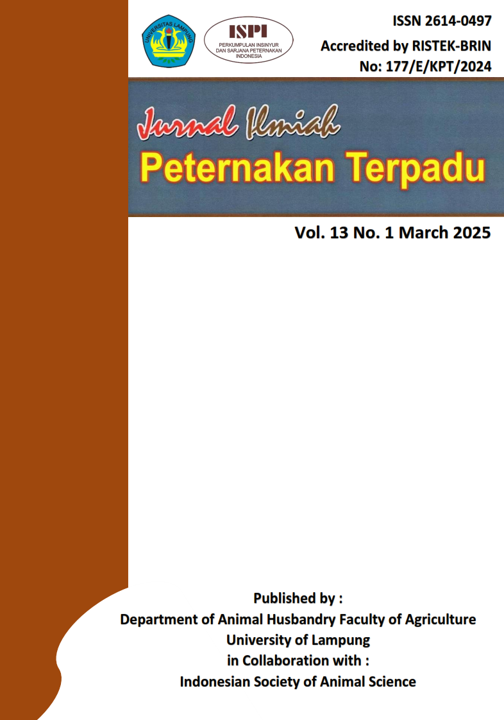Estimation of Carbon Balance in Semi-Intensive Buffalo Farming in Surajaya Village, Pemalang, Central Java
DOI:
https://doi.org/10.23960/jipt.v13i1.p151-160 Abstract View: 269
Abstract View: 269
Keywords:
Enteric Methane Emissions, Carbon Sequestration, Mud Buffalo, Semi IntensiveAbstract
Emissions from the livestock sector are mostly produced by enteric fermentation through saltpeter produced by ruminants. This research aims to determine the carbon balance in semi-intensive buffalo farming in Surajaya Village, Pemalang, Central Java. This research is quantitative descriptive. With a population of 204 buffalo in Surajaya Village, Pemalang, Central Java. A total of 52 samples in the form of buffalo chest circumference measurements were taken using accidental sampling technique. Then the samples were categorized based on production status to be converted to livestock units and estimates of enteric fermentation emissions were calculated using the IPCC AFOLU (2006) tier-2 method. The research results showed that the concept of buffalo silvopasture and teak forests had a positive impact on carbon balance. Enteric methane emissions are estimated at 176.58 tonnes Gg CO_2-eq/year and estimated carbon absorption at 844,306.67 tonnes. So that livestock can be maximized to accommodate 730,273.64 AU in the existing 1830 hectare area of teak forest land.Downloads
References
Akhadiarto, S. & Rofiq, M. N. (2017). Estimasi emisi gas metana dari fermentasi enterik ternak ruminansia menggunakan metode Tier-1 di Indonesia. Jurnal Teknologi Lingkungan, 18(1), 1-8.
Alinus, R., & Linda, R. (2017). Biomassa dan cadangan karbon di Kawasan Agroforestri Karet Tradisional di Desa Nanga Pemubuh Kecamatan Sekadau Hulu Kabupaten Sekadau. Protobiont, 6(3), 249-254.
Ariyanti, D., Wijayanto, N., & Hilwan, I. (2018). Keanekaragaman jenis tumbuhan dan simpanan karbon pada berbagai tipe penggunaan lahan di Kabupaten Pesisir Barat Provinsi Lampung. Journal of Tropical Silviculture, 9(3), 167-174.
Badan Pusat Statistik Kabupaten Pemalang. (2023). Kabupaten Pemalang dalam angka Pemalang regency in figures 2023. Pemalang: BPS Kabupaten Pemalang.
Badan Pusat Statistik Kabupaten Pemalang. (2024). Kabupaten Pemalang dalam angka Pemalang regency in figures 2024. Pemalang: BPS Kabupaten Pemalang.
Balcombe, P., Speirs, J. F., Brandon, N. P., & Hawkes, A. D. (2018). Methane emissions: choosing the right climate metric and time horizon. Environmental Science: Processes & Impacts, 20(10), 1323-1339.
Firdaus, F. (2023). Mitigasi jejak karbon (Carbon Footprint) sektor peternakan berbasis vegetasi di Yogyakarta. Prosiding Seminar Nasional Hasil Penelitian dan Pengabdian Masyarakat. 77-89.
IPCC. (2006). IPCC Guidelines for national greenhouse gas inventories-A primer, Prepared by the national greenhouse gas inventories programme. Eggleston HS, Buendia L, Miwa K, Ngara T, Tanabe K, editors. Hayama (Japan): Institute for Global Environmental Strategies (IGES).
Karim, M.A., Purwiyanto, A.I.S., & Agustriani, F. (2019). Analysis of carbon content (C) production rate of mangrove litter at Pulau Payung, Banyuasin District. Marine Science Research Journal. 11(1), 1–8.
Mayulu, H., & Daru, T. P. (2019). Kebijakan pengembangan peternakan berbasis kawasan: studi kasus di Kalimantan Timur. Journal of Tropical AgriFood, 1(2), 49-60.
Mustikaningrum, D., & Rosida, A. (2023). Estimasi Sekuestrasi Karbon Pada Tanaman Pokok Hutan Produksi Di Kabupaten Tuban, Jawa Timur. Jurnal Tanah dan Sumberdaya Lahan, 10(1), 143-148.
Nur, K., Atabany, A., Muladno, M., & Jayanegara, A. (2015). Produksi gas metan ruminansia sapi perah dengan pakan berbeda serta pengaruhnya terhadap produksi dan kualitas susu. Jurnal Ilmu Produksi dan Teknologi Hasil Peternakan, 3(2), 65-71.
Pazla et al. (2022). Upaya Mengurangi Gas Metan dari Sektor Peternakan. Indramayu: Penerbit Adab.
Peters, G. & Thompson, R. L (2020). Nitrous oxide: A potent, long-lived, and rapidly increasing greenhouse gas. CICERO. https://cicero.oslo.no/en/articles/nitrous-oxide-a-potent-long-lived-and-rapidly-increasing-greenhouse-gas
Standar Nasional Indonesia. (2020). SNI 7706-1:2020 Bibit kerbau-bagian 1: Lumpur. Badan Standarisasi Nasional.
Sugiyono. (2016). Metode Penelitian Kuantitatif, Kualitatif dan R&D. Bandung: PT Alfabet
Wahyudi, J. (2017). Jejak Karbon Produksi Susu pada Peternakan Sapi Perah Rakyat di Kabupaten Pati. Prosiding Sains Nasional dan Teknologi, 1(1), 72-77.
Downloads
Published
How to Cite
Issue
Section
License

Jurnal Ilmiah Peternakan Terpadu(JIPT) is licensed under a Creative Commons Attribution 4.0 International License.
Authors who publish with this journal agree to the following terms:
- Authors retain copyright and grant the journal right of first publication with the work simultaneously licensed under a Creative Commons Attribution License that allows others to share the work with an acknowledgement of the work's authorship and initial publication in this journal.
- Authors are able to enter into separate, additional contractual arrangements for the non-exclusive distribution of the journal's published version of the work (e.g., post it to an institutional repository or publish it in a book), with an acknowledgement of its initial publication in this journal.
- Authors are permitted and encouraged to post their work online (e.g., in institutional repositories or on their website) prior to and during the submission process, as it can lead to productive exchanges, as well as earlier and greater citation of published work (See The Effect of Open Access).





















